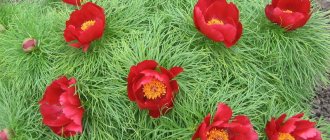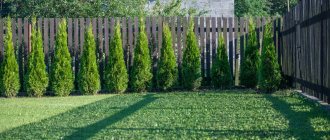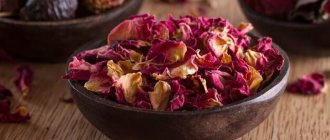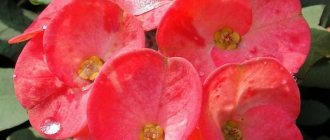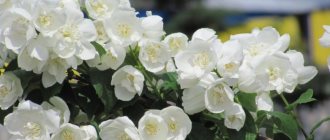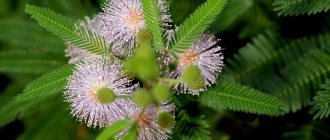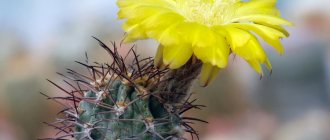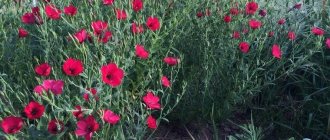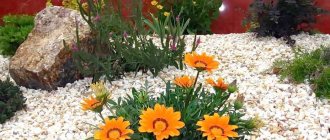Euphorbia marginata or Mountain snow is also called Euphorbia marginata. They came up with this name because its flowers and foliage resemble beautiful snow globes. It has green leaves edged with white. Euphorbia fringe began to be grown in the 19th century.
It grows naturally in the mountains of North America.
This plant is an annual. Attention! Euphorbia Mountain Snow is poisonous; the leaves and stems contain a milky sap that has poison - euphorbine.
Plant characteristics
The photo shows that milkweed has straight stems with many faded green oval leaves. When the plant begins to bloom, a wide white edge appears on the leaves. The leaves can be either pointed or round. It has small, inconspicuous flowers, they are light. The stems are up to 80 cm in height.
Due to the poisonous milky sap that is found on the foliage and stems, the plant should be cared for carefully.
When and how does it bloom
Euphorbia flower Milya - how to care for it at home
The flowering of mountain milkweed is invisible, as it is lost against the background of variegated leaf blades.
Types of flowers
Very small white flowers are collected located at the very top of the stems. In the very middle, yellow-green stamens are very noticeable on them. Because of their shade, the buds practically merge with the background of large white-green leaves.
Flower shapes
Umbrella-shaped inflorescences have from 3 to 7 flowers, each of which includes 5 petals. The buds look like daisies with wide semicircular petals
Flowering period
Flowering of early snow begins in late May and lasts until mid-June. Towards the end of summer, a second wave begins, which is not as abundant as the previous blooming of buds.
How to care for the Mountain Snow variety
Euphorbia fringe is an unpretentious crop; planting and caring for the plant is easy; even a beginner can grow it.
Watering the plant
The crop should be watered moderately; the plant should not be overwatered.
Important! Mountain snow can survive drought, but will die if it gets too wet.
In summer, water once a week so that the soil is slightly moistened. The crop grows actively when the soil is dry. If the moisture stagnates, the plant’s rhizomes rot.
In winter, in an apartment, the plant is watered with a minimum amount of water; this is done when the soil is completely dry. The plant is not sprayed. It easily tolerates proximity to heating radiators.
Lighting and temperature
The plant loves light and warmth. The air temperature should be +23-24°C. In summer cottages, spurge grows right up to frost. But it is planted in the flowerbed in the spring as an annual.
Important! The crop grows poorly in shade; it is planted in the most illuminated area. And in the house it is placed on the southern windowsill.
But mountain snow can also grow in somewhat shaded places.
Soil and plant nutrition
The culture can take root on sandstone and rocky soil, but it still likes fertile soils.
The soil for the plant is made light, loose, fertile; the soil should be slightly acidic.
A thin layer of agroperlite is poured onto the bottom of the pot. The substrate is mixed from sand, leaf and turf soil.
Euphorbia prefers feeding with a solution of 200 g of manure and a bucket of clean water (10 l). Mullein is infused for a day, and then euphobia is poured over it in the evening.
Choosing the right pot for milkweed
Typically, seeds are planted in pots and then seedlings are planted in the area. To do this, take small cups or peat pots.
If you nevertheless decide to plant a garden plant in an apartment, then select wide but shallow pots.
Growing
The soil . To grow it in the garden, you need warm, sunny places, protected from the winds. The plant is absolutely undemanding to the soil factor. Both scanty rocky and sandy substrates are suitable for it. Although, of course, on fertile and loose soil, spurge feels much more comfortable
Watering . Overmoistening the soil can be disastrous for euphorbia. Therefore, wet depressions with high groundwater levels should be avoided when choosing a planting site. But the plant tolerates drought well and does not need frequent watering. This is one of those cases where it is better to underwater than to overwater.
Euphorbia marginata Snow on the Mountain
Diseases and pests
The plant rarely gets sick. If not properly cared for, the crop can be affected by fungal diseases. At the same time, the leaves turn yellow and then fall off. Then the plants are sprayed with fungicides.
Pests include:
- spider mites;
- nematodes;
- slugs
To eliminate insects, plants are sprayed with insecticides.
Diseases characteristic of the flower
The variety is hardy and resistant to diseases and garden pests. Watering is only necessary in dry summers.
Watering is carried out at the root; water should not get into the leaf rosettes . Stem and root diseases may appear - milky rot, gray rot. The flower does not tolerate dampness and excessive moisture; powdery mildew and mosaic viruses may appear on the leaves.
It is also not recommended to plant bushes in shady places; from lack of light, the bushes wither and die.
Euphorbia mountain snow not only decorates flower beds, rockeries and flower beds. Experienced gardeners specially plant this flower around the perimeter of the plot, along the beds - it perfectly “guards” the garden from rodents and moles.
Growing milkweed from seeds
Sowing seedlings
Growing from seeds begins with soaking them for 2 hours in warm water.
When to plant seeds for seedlings?
From late February to mid-April, you can sow seeds indoors in a 12 cm high container filled with soil. For the substrate, make a mixture of loam and sand. Pour the seeds, slightly press them to a depth equal to the diameter of the seeds, and spray them with a spray bottle.
Then the seeds are lightly sprinkled with a mixture of peat and sand. Next, cover with film. Afterwards they are placed in a room with a temperature of 17-18 degrees. Remove the film daily to ventilate the plantings and monitor soil moisture. The first shoots hatch in 1-2 weeks. Then the film is removed.
From the video you will learn how to do it correctly:
How to dive?
When the seedlings grow 1-2 true leaves, they are planted in separate cups.
Sowing in open ground
At the end of May, seeds are sown on the plot. This is done when return frosts no longer appear. The seeds are planted to a depth of 6 cm. After 2 weeks, sprouts will sprout.
How to plant seedlings?
By the end of May, when the soil has finally warmed up, the seedlings are placed in a sunny area. A space of 30 cm is made between the planting holes. The stems of young milkweed are faded green, with white hairs visible on them, then the stems acquire a brownish-green tint.
You should not plant the crop in an area with close groundwater.
Is it necessary to pinch in the flowerbed?
You can pinch the top of the plants, this makes their growth more active.
How to plant Euphorbia marginata with seeds in open ground
How to sow spurge bordered in the ground photo of seedlings
Sowing milkweed seeds in open ground is carried out in the spring (around the beginning of May), or before winter, 3-4 weeks before the onset of frost (so that the seeds do not have time to sprout in the fall and the seedlings do not die from frost). The plant also self-sows well.
Euphorbia marginata seeds are large enough to be sown less frequently. Make shallow furrows at a distance of 25-30 cm. The seeding depth is 1-2 cm, the distance between seeds is 7-8 cm. When seedlings appear, the plants are thinned out in several stages. Excess seedlings can be transplanted as seedlings. The final distance between the bushes in a row is 25-30 cm.
Bordered spurge in landscape design
In flower beds, Mountain Snow looks great next to phlox, ornamental grasses, and monarda. It makes an excellent backdrop for many perennials.
It goes well with hostas that also love bright sunlight. It harmonizes well with crops that have dark foliage, for example, varietal buzulniks.
If you cut it, you can use it to make bouquets, combining it with roses, hollyhocks, delphiniums, and dahlias.
Gardeners plant Mountain Snow because of its unpretentiousness and beautiful decorative leaves. It does not require frequent watering as it tolerates drought easily.
Purchase and adaptation
Seeds are affordable for everyone
This plant is an annual plant, so it is sold by seeds in flower shops. The cost is very low - 10-30 rubles, depending on the weight of the package.
The most popular varieties among gardeners are the Rich Bride and Mountain Snow varieties.
Seedlings are rarely sold, mainly in nurseries or on the market. This is explained by the fact that euphorbia is easy to grow yourself. The added value is too low to interest sellers. No adaptation required. Seedlings appear on sale already in the warm season.
Problems and their solutions
There are rarely any problems when growing bordered milkweed. The plant is resistant to diseases and is not too demanding on growing conditions.
| Problem | Cause | Ways to solve the problem |
| Leaves turn yellow and dry out | Lack of light or minerals | You need to choose a sunny place to grow milkweed. Add additional organic fertilizers |
| Roots and stems rot | Excessive watering, stagnation of water | It is necessary to adjust watering and cut off damaged parts of the plant |
| Dark spots appear on the leaves | Fungal diseases due to high humidity | Reduce watering. Spray the plant with fungicidal preparations |
Yellowing of leaves
Signs and superstitions
Many signs and superstitions are associated with cypress spurge:
- It is unacceptable to place a flower in rest rooms. The presence of tubercles and thorns on plants can negatively affect the relationship between spouses;
- The second name for cypress milkweed is palm of misfortune. It is believed that living in the apartment of such a green friend can lead to troubles in all areas of life;
- If you display pots with the plant in the hallway, you can be sure that euphorbia will protect and protect your home.
Modern gardeners have fallen in love with Euphorbia cypress due to its unpretentiousness. Even with minimal care, the plant will bloom profusely and delight the owner of the garden plot with its chic appearance.
Peculiarities
Euphorbia fringe is a poisonous plant whose milky juice contains euphorbine. Biologists call this plant “euphorbia marginalata”, “mountain snow” and “snow in the mountains”. The plant belongs to the Euphorbiaceae family and is an annual. The natural habitat of this flower is the mountain slopes of the United States. The appearance of the flower resembles a snow-white ball. A distinctive feature is the presence of a white border on the leaves.
The annual plant has straight stems up to 85 cm high with pale green leaves. The shape of the leaves can be either round or pointed. The inflorescences are small in size and white in color. The flowering period lasts from mid-summer to early winter.
At home, the plant can live for several years, so it automatically becomes a perennial.
Bloom
The flowering period begins in July and ends with the onset of the first frost.
The flowers are small and white.
An amazing feature of “early snow” is that at the time of flowering, a bright white border appears on the upper leaves located under the unsightly flowers.
The plant appears to be decorated with huge caps of flowers.
This magical transformation justifies one of its names - “rich bride”.
Milkweed propagation methods
Euphorbia can be propagated in three ways - by dividing the bush, cuttings and, of course, seeds. Most species of Euphorbia reproduce well on their own by self-seeding.
Since Euphorbia is a dioecious plant, it is necessary that two bushes be planted nearby - a female and a male. Only in this case will the plant be able to reproduce independently. Unfortunately, it is impossible to immediately determine which bush it is - male or female; this will become clear only during flowering. Male flowers are narrow and long, with large pistils inside, but female flowers are wide, strewn with many stamens.
